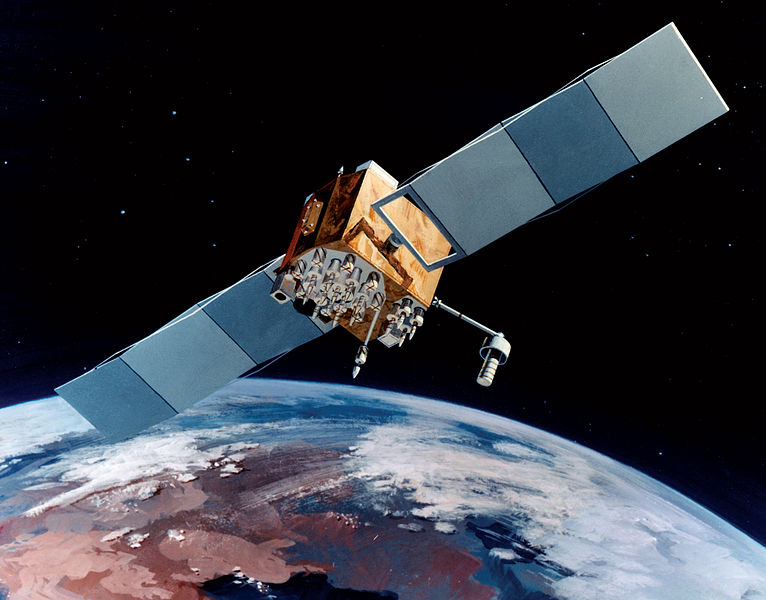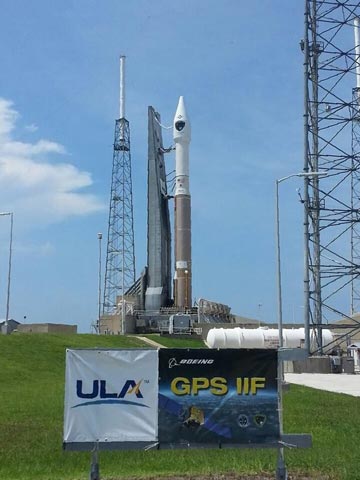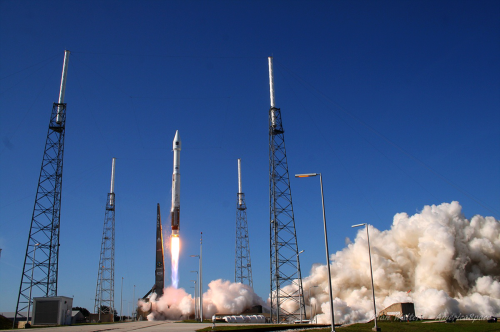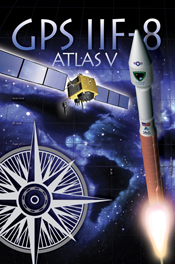
Adding to an already impressive tally of accolades, United Launch Alliance (ULA) is ready to stage its 12th flight of the year, delivering the Global Positioning System (GPS) IIF-8 satellite into a medium orbit, some 11,047 nautical miles (20,460 km) above Earth. Liftoff is presently targeted for 1:21 p.m. EDT Wednesday, 29 October, from Space Launch Complex (SLC)-41 at Cape Canaveral Air Force Station, Fla., at the opening of an 18-minute “window.” It marks the fourth GPS mission of 2014—following hard on the heels of GPS IIF-5 in February, GPS IIF-6 in May, and GPS IIF-7 in August—as ULA progresses toward completion of the 12-strong “Interim” Block IIF constellation of global positioning, velocity, and timing satellites. The mission will be undertaken by the workhorse Atlas V, flying in its “401” configuration, which boasts a 13-foot-diameter (4-meter) payload fairing, no strap-on boosters, and a single-engine Centaur upper stage.
Launching for the 12th time in just 10 months is an admirable feat for ULA, which was formed in December 2006 as a joint venture between Lockheed Martin and Boeing. Headquartered in Centennial, Colo., the launch services organization operates the Atlas V, Delta IV, and Delta II vehicles from Cape Canaveral Air Force Station, Fla., and Vandenberg Air Force Base, Calif., delivering a variety of commercial, scientific, and military payloads into low, medium, and geosynchronous orbits, as well as “escape trajectories” to other destinations in the Solar System.
Yet even a dozen flights in one calendar year is not an all-time record for ULA. In 2009, the company launched no fewer than 16 Atlas and Delta missions, whilst even 2007—its first full year of operations—saw a total of 13 launches. The various configurations of the Delta II and Delta IV have been flown a maximum of 11 times in a single year, whilst the Atlas V has peaked at eight launches per annum. With Wednesday’s flight of GPS IIF-8, it will tie the record for the highest number of Atlas boosters launched in a single calendar year, which is set to be broken and a new “personal best” established by ULA in December 2014, when a ninth Atlas carries the classified NROL-35 payload into orbit for the National Reconnaissance Office. By the close of 2014, it is anticipated that the company will have executed a grand total of 14 missions, capped by NASA’s long-awaited Exploration Flight Test (EFT)-1 “shakedown” voyage of the new Orion spacecraft on 4 December.

What does make the GPS IIF-8 launch special is the fact that it is the 50th flight of an Atlas V, since the rocket’s maiden mission in August 2002. Since then, its various configurations—which run the gamut in capability from the “barebones” Atlas V 401 to the Atlas V 551 heavylifter, with its 16-foot-diameter (5-meter) payload fairing, five strap-on boosters, and a single-engine Centaur upper stage—have delivered 55 primary payloads into space. These have included several commercial communications satellites and a range of military payloads, including members of the Wideband Global Satcom (WGS), the Defense Meteorological Satellite Program (DMSP), the Advanced Extremely High Frequency (AEHF), geostationary-orbiting elements of the Space-Based Infrared System (SBIRS), and a pair of heavyweight Multi-User Objective System (MUOS) communications satellites. Additionally, the Atlas has delivered a number of classified payloads on behalf of the National Reconnaissance Office (NRO) and has launched the Orbital Test Vehicle (OTV)-3 mini-shuttle (also known as the “X-37B”) on three occasions in April 2010, March 2011, and December 2012. The most recent OTV-3 mission ended earlier this month, with a successful landing at Vandenberg Air Force Base, after 675 days aloft.
Although the Atlas V’s pedigree has been dominated by military payloads, it has also delivered a number of important missions of exploration into the heavens. These include the Mars Reconnaissance Orbiter (MRO) in August 2005, the Pluto-bound New Horizons in January 2006, the Lunar Reconnaissance Orbiter (LRO) and Lunar Crater Observation and Sensing Satellite (LCROSS) in June 2009, the Solar Dynamics Observatory (SDO) in February 2010, the Jupiter-headed Juno orbiter in August 2011, the Mars Science Laboratory (MSL) and Curiosity rover in November 2011, the Van Allen Probes in August 2012, and, most recently, the Mars Atmosphere and Volatile EvolutioN (MAVEN) spacecraft in November 2013.
At the time of writing, the standard Launch Readiness Review (LRR) took place yesterday (Monday, 27 October) and the 196-foot-tall (60-meter) Atlas V booster for the GPS IIF-8 mission was due to roll out, atop its Mobile Launch Platform (MLP), from the Vertical Integration Facility (VIF) at the Cape, on Tuesday, 28 October, for the 35-minute journey to SLC-41. Upon arrival at the pad, it will be carefully centered and propellant umbilicals and electrical and data links will be connected. The track mobiles will then be removed and ULA engineers will prepare for formal GPS IIF-8 countdown operations, which are slated to begin early tomorrow (Wednesday). According to Patrick Air Force Base meteorologists, the weather situation on Wednesday afternoon is expected to be mostly cloudy, with a 10 percent probability of rain showers, but no severe weather or lightning anticipated. Overall, ULA expects a 70-percent likelihood of acceptable conditions to fly at T-0.
GPS IIF-8, which arrived at the Cape for final processing on 16 July, is the fourth of its kind to be launched in 2014 and will represent the 12th overall GPS to be lofted atop a ULA booster and only the third to ride atop an Atlas V. It is anticipated that the 12-strong GPS Block IIF network will employ a mixture of Atlas V and Delta IV launches, with the latter having been employed to insert GPS IIF-1, GPS IIF-2, GPS IIF-3, GPS IIF-5, and GPS IIF-6 into orbit. The forthcoming GPS IIF-9 and GPS IIF-10 satellites—currently scheduled to fly in 2015—will both be carried aboard Delta IVs. These “Interim” Block IIF satellites will help to keep the Navstar system of worldwide positioning, velocity, and timing assets fully operational until the next-generation GPS Block IIIA comes online in 2016.

Atlas V 401’s Russian-built RD-180 engine, with a propulsive yield of 860,000 pounds (390,000 kg), will ignite about 2.7 seconds ahead of Friday’s liftoff, burning a mixture of liquid oxygen and a refined form of rocket-grade kerosene, known as “RP-1.” Climb-out from SLC-41 will commence at T+1.1 seconds, and the pencil-like vehicle will climb vertically for about 16 seconds, after which the avionics of the Centaur upper stage will command a pitch, roll, and yaw program maneuver. This will establish the Atlas onto the proper flight azimuth of 45.8 degrees, following a north-easterly trajectory to inject the 3,600-pound (1,630-kg) GPS IIF-8 satellite into orbit.
After the shutdown of the RD-180—whose Russian heritage has made ULA the subject of much criticism in 2014, particularly in light of sanctions issued after the Kremlin’s annexation of Crimea in March—about four minutes into the flight, the 41-foot-long (12.4-meter) Centaur and attached GPS IIF-8 will be detached, prior to two “burns” to achieve a target orbit of 11,047 nautical miles (20,460 km), inclined 55 degrees to the equator. Ignition of the Centaur’s 22,300-pound-thrust (10,100-kg) RL-10A engine for the first time will occur about 10 seconds after the separation of the Atlas V’s first stage. It employs a cryogenic combination of liquid oxygen and hydrogen and is designed to be restartable.
The first firing will be followed by the jettisoning of the two-piece (or “bisector”) payload fairing to expose GPS IIF-8 to the space environment for the first time. According to ULA’s launch brochure, the initial burn is scheduled to last 13 minutes, after which the Centaur/payload combo will coast for almost three hours, ahead of a second burn, lasting just 90 seconds. After this event, the Centaur will spin-up GPS IIF-8 to five revolutions per minute and release it into space at T+3 hours, 24 minutes, and 17.5 seconds.
Throughout Wednesday’s ascent phase, telemetry data will be gathered by the Eastern Range, together with various worldwide installations under the U.S. Air Force Space Command Network, including New Boston Air Force Station, N.H., the Royal Air Force’s Oakhanger installation in Hampshire, England, Diego Garcia in the Indian Ocean, and Guam in the western Pacific Ocean. Additionally, NASA’s Tracking and Data Relay Satellite System (TDRSS) will participate in the gathering of telemetry.

From its semi-synchronous, medium-altitude Earth orbit, GPS IIF-8 will circle Earth once every 12 hours. It represents the seventh satellite in a 12-strong network of GPS Block IIF spacecraft, the first of which was launched in May 2010. A second satellite followed in July 2011, then a third in October 2012, a fourth in May 2013, a fifth in February 2014, a sixth in May 2014, and a seventh in August 2014.
The GPS IIF boasts improved positioning, velocity, and timing accuracy, a reprogrammable processor, an interference-free civilian signal for commercial aviation search and rescue, and a new Military code (or “M-code”) to offer better resistance to electronic jamming. “As each IIF satellite becomes operational, we continue the seamless transformation of the GPS constellation into an even more accurate, reliable, and durable navigation resource for the U.S. military and the global civilian user community,” said Craig Cooning, vice president and general manager of Boeing Space & Intelligence Systems. “Our efficient pulse-line manufacturing process, adapted from Boeing’s commercial airplane production lines, also ensures that we deliver each spacecraft on time and on cost.”
In the meantime, the Air Force expects the next-generation GPS IIIA network to enter service no earlier than April 2016, about two years later than originally intended. It awarded a $1.4 billion contract to Lockheed Martin in May 2008 to develop this new network, which may eventually comprise as many as 32 satellites, although the Air Force has only formally contracted for four of these. With 500 times the transmitter power of current systems, the IIIA satellites will benefit from improved navigational warfare capabilities, enabling them to shut off GPS services to limited geographical locations, whilst maintaining service to U.S. and allied forces. The GPS satellite system is operated and controlled by the 50th Space Wing, located at Schriever Air Force Base, Colo.
Want to keep up-to-date with all things space? Be sure to “Like” AmericaSpace on Facebook and follow us on Twitter: @AmericaSpace
Missions » GPS » GPS IIF-8 »


